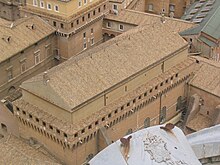Roman school

The Roman School was a group of Renaissance composers who worked in Rome from the middle of the 16th century to the 17th century and who implemented the church music demands of the Counter-Reformation that had been formulated at the Council of Trent .
The actual founder of the Roman school is Giovanni Pierluigi da Palestrina , whose works - especially the Missa Papae Marcelli and the Stabat Mater - were considered key works and models in terms of style and aesthetics . Other famous composers are Tomás Luis de Victoria and Gregorio Allegri . Other important representatives were: Vincenzo Ruffo , Nicola Vicentino , Felice Anerio , Giovanni Francesco Anerio , Giovanni Maria Nanino , Bernardino Nanino , Ruggiero Giovanelli , Francesco Suriano , Cristofano Malvezzi , and later Pietro Paolo Bencini .
The Council of Trent only allowed polyphonic music to be performed in churches under specified conditions:
- The most important condition was the comprehensibility of the text.
- there was also dignity and appropriate expression , depending on the church festival and the occasion.
- Parody masses based on secular works such as chansons or madrigals were forbidden because the often very well-known models often had erotic texts that were understandably felt to be completely inappropriate in a religious context.
The Roman school continued and developed the Dutch polyphony further, in the interests of simplification. One of the most important differences to the traditional Dutch school was the increased inclusion of homophonic passages, which resulted from the demand for the best possible text intelligibility. Nevertheless , the focus was on polyphonic vocal music for several voices , which is calm and flowing in melodic , harmonic and rhythmic terms.
In the 17th and 18th centuries, the Roman style was also seen as a model for church music outside of Rome, but it also stood in a certain contrast to the more progressive Venetian style in the sense of Giovanni Gabrielis and Monteverdi , which is even more homophonic and especially z. Partly solo instrumental parts included.
See also
Individual evidence
- ↑ Michael Heinemann: Giovanni Pierluigi da Palestrina und seine Zeit , Laaber-Verlag, Regensburg 1994, p. 35 and p. 55.